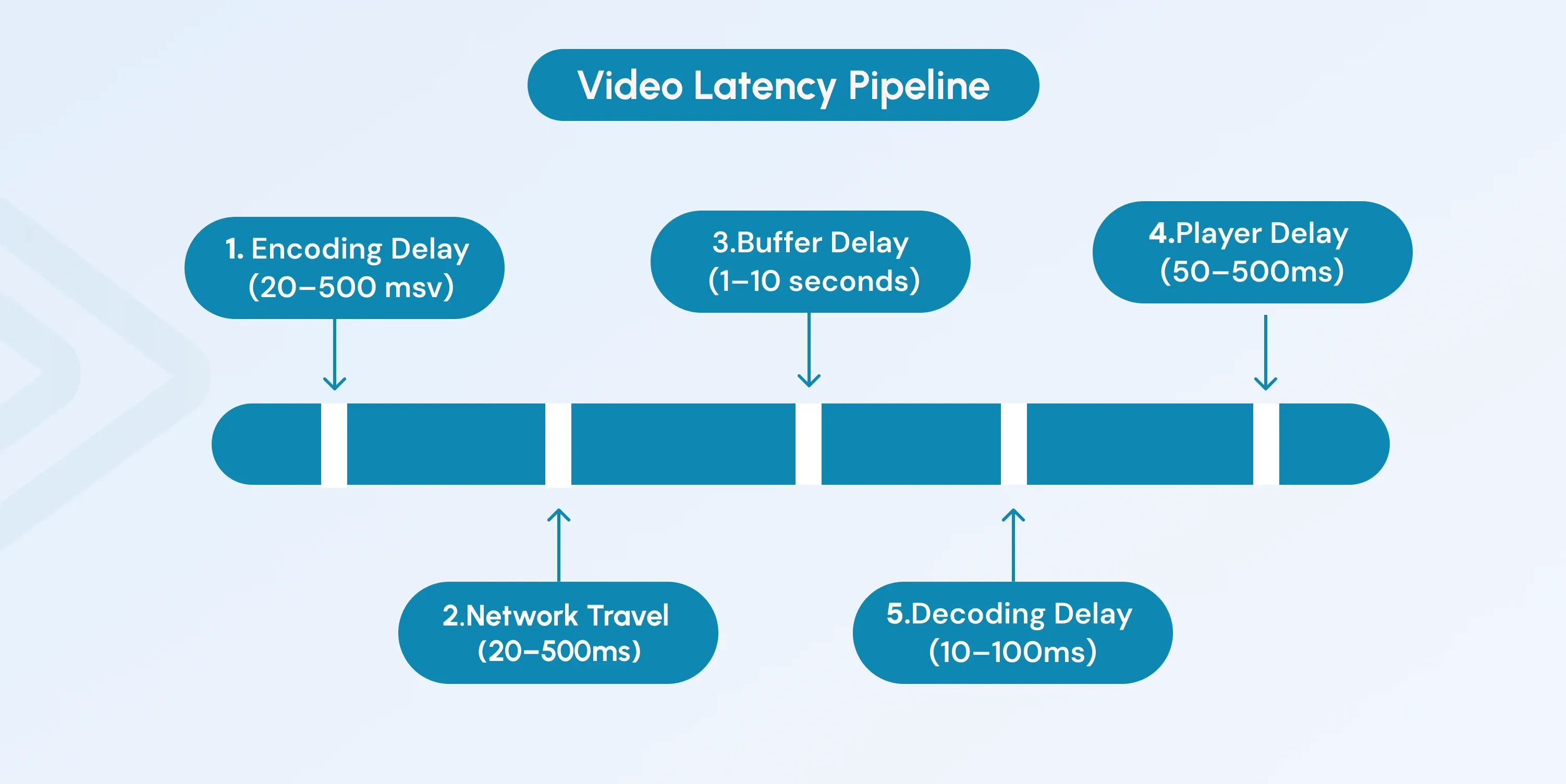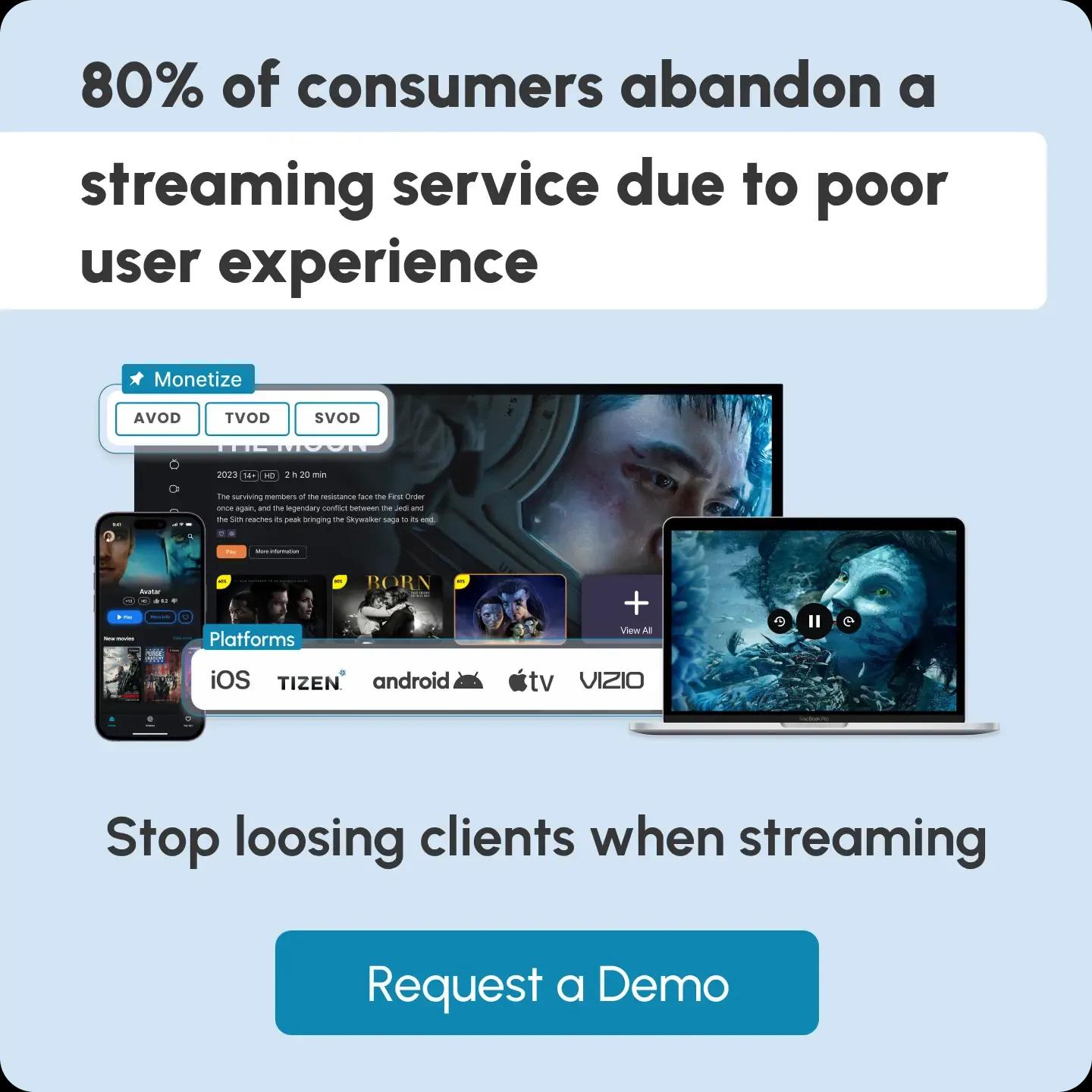
What is Video Latency? Understanding Streaming Delays
Think of video latency as the digital journey your content takes from camera to screen - the longer it takes, the greater the impact on viewer engagement and content effectiveness.
High streaming latency can cause viewers to miss key moments in live events, struggle with interactive sessions, or experience frustrating delays in video calls. So if you want high-quality streaming, managing video latency is crucial.
This guide covers what video latency is, the causes, strategies to reduce it, and key metrics. Ready? Let’s get into it.

Key Takeaways
- Video latency refers to the delay between the moment content is captured and the viewer’s playback.
- Different types of streaming require different latency thresholds.
- Multiple factors contribute to streaming delays, from encoding to network conditions.
- Strategic solutions can help minimize latency for better viewer engagement.
- Choosing the right streaming setup is crucial for managing latency effectively.
What is Video Latency?
Video latency refers to the delay between capturing video content on a camera and its appearance on a viewer's screen.
It’s a measurement of the time it takes for a video signal to travel from source to destination. This delay, calculated in milliseconds or seconds, affects everything from live sports broadcasts and video conferences to interactive streaming experiences.
Video latency typically ranges from 200 milliseconds in ultra-low latency applications to several minutes in traditional broadcasting setups. For context, human perception begins to notice delays at around 100–200 milliseconds, making this threshold particularly important for interactive streaming applications.
Note for content creators and TV operators: Latency has a direct impact on viewer engagement and satisfaction. High latency can disrupt the viewing experience, especially during live events where real-time interaction is crucial. That’s why low-latency video streaming is a must to elevate your streaming services.
Understanding how streaming latency impacts your content can help you make informed decisions about your setup and choose the best solutions.
5 Components of Video Latency
Video latency isn’t just one delay. It’s the result of multiple processes throughout the streaming pipeline. Here’s how each stage contributes to streaming latency:

Encoding Delay (20–500ms)
During the initial encoding stage, raw video must be compressed and converted into a streamable format. Hardware encoders, like live streaming encoders, for example, typically process frames faster than software solutions, but both add necessary processing time.
Network Travel Time (50–500ms)
Once encoded, data packets travel through the internet infrastructure, with distance and network conditions affecting their travel time. Each network hop adds latency, typically 5–100ms per hop, depending on network congestion, geographic server distance, and routing efficiency.
Buffer Delay (1–10 seconds)
To ensure smooth playback, video players build a buffer of content segments. The size of this buffer directly impacts total latency, with larger buffers providing more stability but increased delays.
Decoding Delay (10–100ms)
Once received, the viewer’s device decompresses and processes the video. Performance depends on device capabilities and the complexity of the codec (e.g., AV1, H.265, H.264) used to encode the content.
Player Delay (50–500ms)
Finally, the video player renders the content on-screen. This last processing step adds another layer of latency, influenced by software optimizations and hardware performance. For example, specific streaming platforms with added processing (like overlays or DRM decryption) can push it toward the upper limit.
What Causes Video Latency?
Several critical factors contribute to streaming delays or video latency across various scenarios. Whether you’re an operator or content creator, it’s important to understand the following different causes.
Network Conditions
Complex network infrastructures create significant streaming challenges. Poor connectivity, geographic distance, and bandwidth limitations dramatically impact content delivery.
Throw in internet service providers’ (ISPs) routing, network congestion, and unpredictable packet loss—all additional factors that can introduce substantial delays, making consistent real-time streaming performance a complex technical challenge.
Technical Configuration Factors
The way a streaming platform is configured directly affects the streaming latency. Choices like video resolution and bitrate require a balance between quality and speed—higher resolutions demand more processing power and bandwidth, potentially increasing latency.
Additionally, codec selection, CDN routing, and player buffer settings all play a role in optimizing the viewer experience.
Hardware Performance Limitations
The physical infrastructure behind streaming significantly impacts video latency. Server processing power determines how fast content is encoded and delivered.
High-density streaming environments require robust computational resources to maintain stability. On the viewer’s end, device capabilities and decoding performance introduce further variability in content delivery speed.
Encoding Complexity
Video compression technologies are crucial for efficient streaming, but they also introduce processing delays. Advanced encoding techniques that prioritize higher quality require more computational resources, increasing encoding time.
The trade-off between video quality and transmission speed is a key factor in achieving acceptable latency for use cases like video conferencing and live streaming.
Geographic Distribution
The physical distance between content servers and viewers creates inherent latency challenges. Global streaming platforms must use advanced CDN strategies to minimize geographic transmission delays while ensuring consistent performance across different network environments.
The Impact of Video Latency on the User Experience

Video latency has a direct effect on viewer engagement and content effectiveness. Delays in streaming latency can significantly alter how users interact with and experience content, leading to frustration, disengagement, or even platform abandonment.
Here’s how video streaming latency impacts different scenarios:
Live Events
High streaming latency can ruin the immediacy of live experiences. Sports fans may receive goal updates on social media before seeing the actual play, while interactive live events lose their spontaneity due to delayed audience participation.
Betting platforms and real-time voting systems are particularly vulnerable, as even slight latency streaming disrupts immediate interactions.
Video Conferencing
Professional communication depends on near-instantaneous interactions. Latency disrupts natural conversation flows, creates awkward communication gaps, and reduces the effectiveness of non-verbal communication.
Important business discussions, remote collaboration, and educational sessions suffer when participants experience noticeable delays in audio and video transmission.
Gaming and Interactive Content
Streaming delays can completely undermine competitive gaming experiences. Professional esports and interactive streaming platforms require millisecond-level responsiveness, and even slight delays can mean the difference between winning and losing in competitive scenarios.
Viewer engagement drops dramatically when real-time interaction becomes impossible.
Entertainment Streaming
Consistent viewing experiences depend on minimal latency. Buffering, stuttering, and unexpected pauses destroy immersion in movies, shows, and live performances.
Viewers become frustrated, often abandoning platforms that cannot deliver smooth, uninterrupted content.
Educational and Professional Content
Online learning and professional training platforms require real-time clarity for effective instruction. Streaming delays can make complex explanations harder to follow, interrupt demonstrations, and reduce the overall effectiveness of digital education and training sessions.
In high-stakes environments like virtual labs or medical simulations, video latency can severely impact learning outcomes.
5 Strategies and Features to Minimize Video Latency
Minimizing video latency comes with several challenges that streaming platforms must overcome to ensure smooth and fast content delivery:
- Balancing Quality and Speed: High-resolution streams require more data, increasing the time it takes for content to travel across networks. While compression techniques help reduce file sizes, overly aggressive compression can degrade visual fidelity and lead to artifacts like pixelation, blurring, and frame skipping that impact viewer satisfaction.
- Handling Network Variability: Unlike traditional broadcasts, internet and cloud-based streaming depend on unpredictable network conditions. Fluctuations in bandwidth, congestion, and routing can cause delays, making real-time streaming difficult.
- Optimizing Device Compatibility: Viewers consume content on a wide range of devices, from smartphones to high-end smart TVs, each with different processing capabilities, screen resolutions, and network speeds. This variation means streaming platforms must create multiple renditions of the same content to ensure consistent quality across devices while maintaining low latency.
To tackle these issues, here are five effective strategies and features to reduce video streaming latency:
Adaptive Bitrate Streaming (ABR)
Adaptive bitrate streaming dynamically adjusts video quality based on viewers' internet speeds. By creating multiple video versions at different quality levels, ABR ensures smooth playback across diverse network conditions.
The system intelligently switches between quality levels to maintain the best possible viewing experience without interruption.
Multi-Device Compatibility
Modern streaming requires support across numerous devices. By generating device-specific video renditions, platforms can ensure a consistent viewing experience on smartphones, tablets, smart TVs, and web browsers. This approach considers the unique processing capabilities and screen characteristics of each device type.
Content Delivery Network (CDN) Integration
Strategic CDN implementation accelerates global content distribution while significantly reducing latency. CDNs store content in multiple locations worldwide, routing users to the nearest server to minimize transmission delays and optimize streaming quality.
That’s why a live streaming CDN is crucial for minimizing latency and maintaining stability.
AI-Powered Video Optimization
Machine learning technologies are revolutionizing video processing. Intelligent systems can now predict and adapt to viewer preferences and network conditions, automatically selecting optimal encoding parameters.
These AI-driven approaches continuously learn and improve, providing increasingly efficient streaming experiences.
Advanced Encoding Techniques
Implementing cutting-edge video compression technologies allows for higher-quality streams with reduced latency. Modern codecs like H.265 and AV1 provide superior compression, enabling platforms to deliver high-quality content more efficiently.
Measuring Video Latency
Accurate video latency measurement is essential for identifying and resolving streaming delays. Since latency can occur at multiple points in the streaming pipeline, a comprehensive approach is necessary to pinpoint and effectively address issues.
Key Latency Metrics
- End-to-End Latency: Measures the total delay from content capture to playback, providing the most relevant metric for overall system performance.
- Network Round-Trip Time (RTT): Identifies connectivity issues by tracking how long it takes for data packets to travel to a destination and back.
- Buffer Health Monitoring: Ensures smooth playback by preventing excessive buffering, which can increase streaming latency.
- Encoding Performance Metrics: Detects processing bottlenecks that slow down content compression and delivery.
- Player Rendering Time: Evaluates client-side performance, identifying delays in video decoding and display.
Tools for Latency Measurement
Professional streaming platforms use specialized monitoring tools to track real-time latency statistics and analyze historical trends. These include:
- Network analysis software to monitor packet movement and detect bottlenecks in content delivery.
- Built-in player statistics to assess client-side playback performance.
- Encoding monitors to measure processing efficiency and output quality.
Measurement Techniques
To measure streaming latency effectively, platforms use:
- Time-stamped packets to track content movement across the network.
- Synchronized clocks for precise delay calculations.
- A/B testing to compare different encoding, delivery, and playback configurations.
- End-user experience monitoring to collect real-world performance data and optimize low-latency video streaming.
These tools and techniques can help you accurately measure and address latency issues promptly without impacting the user experience.
How inoRain Optimizes Video Latency
inoRain delivers a seamless streaming experience, reducing video latency by combining advanced technology with industry expertise.
Our end-to-end OTT solutions are supported by a global CDN network that strategically places edge servers near viewers, minimizing geographic latency and ensuring faster content delivery.
To adapt to network fluctuations, inoRain employs adaptive bitrate streaming (ABR) and intelligent protocol selection, automatically adjusting content delivery based on network conditions and device capabilities.
Conclusion
Video latency remains a critical challenge in the streaming industry that affects viewer satisfaction and content effectiveness across all streaming applications.
Through careful consideration of network conditions, technical factors, and hardware capabilities, organizations can implement effective strategies to minimize latency and improve viewer engagement, with the right partner, such as inoRain, onboard.
As streaming technology advances, latency management tools become more sophisticated. inoRain equips content creators and broadcasters with the expertise and cutting-edge solutions needed to deliver high-quality streaming at scale. If you’re ready to take your streaming experience to the next level, partner with inoRain today.
FAQs
What factors contribute to video latency in streaming?
Network conditions, encoding settings, geographic distance, and hardware capabilities all play crucial roles in determining overall video latency.
How does adaptive bitrate streaming affect latency?
While adaptive bitrate streaming can add some latency, it helps maintain smooth playback by adjusting quality based on network conditions, ultimately improving the viewing experience.
Can live streaming platforms operate effectively with some latency?
Yes, many successful platforms operate with a few seconds of latency. The key is finding the right balance between latency and stream stability for your specific use case.
What impact does video latency have on viewer engagement?
High latency can significantly reduce viewer engagement, especially during live events where real-time interaction is important. Lower latency generally leads to better viewer retention and participation.
What future trends might further reduce video latency?
Emerging technologies like WebRTC, edge computing, and new compression methods continue to push the boundaries of low-latency streaming.
Founder / CEO
Hi, I'm Andranik, the CEO and Co-Founder of inoRain OTT, as well as the Co-Founder of HotelSmarters. I'm passionate about driving innovation in the streaming industry and bringing smart solutions to the Hospitality sector. Let's connect and discuss how to enhance digital content distribution, optimize monetization strategies, and revolutionize hospitality management with data-driven solutions.

OTT Advertising: Types, Best Practices, and Strategies
Over-the-top (OTT) advertising has transformed how brands connect with consumers.

VPlayed Alternatives: inoRain vs. VPlayed
Explore inoRain as a VPlayed alternative, comparing features, pricing, and OTT solutions to find the best platform for your streaming needs.

Custom OTT Platform Development: How to Start an OTT Business
This guide will walk you through everything you need to know about the OTT platform development.
